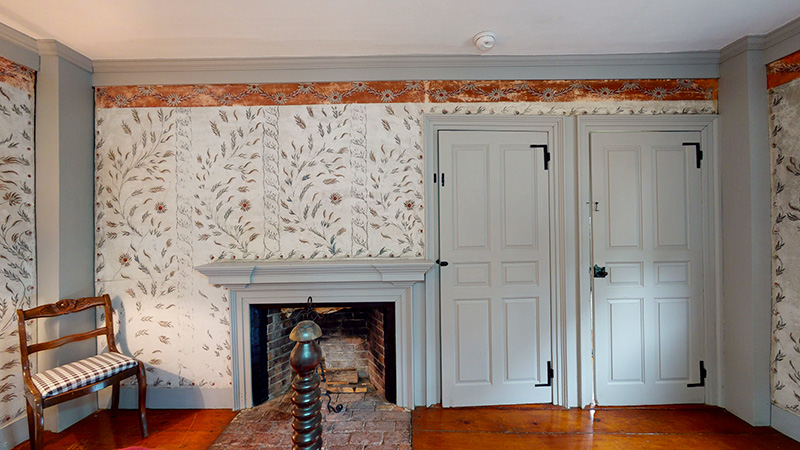Painted Walls: New Virtual Museum Offers an Immersive Experience
Click on images to enlarge them and view captions.
by Margaret Gaertner and Kathleen Criscitiello
The Center for Painted Wall Preservation (CPWP) is dedicated to the research and preservation of 18th- and 19th-century American paint-decorated plaster walls. As part of its mission to document and encourage appreciation of this vulnerable and increasingly rare art form, CPWP identified 40 of the best surviving examples in New England and upstate New York and commissioned photographer Michael Wasserman to photograph and digitally scan 20 of these interiors. Thanks to a Dean F. Failey Grant from the Decorative Arts Trust, CPWP is augmenting this documentation by creating a Virtual Museum of Painted Walls with 360-degree immersive room tours using Matterport technology. The project allows for unprecedented public access to these spaces, most of which are in private homes.
American painted walls can be grouped into three types: freehand brushstroke painted, stenciled, and muraled. The Virtual Museum includes examples of each technique, and visitors will be able to examine and compare entire rooms with intact painted walls, experience the diversity of these artworks, and identify possible connections.
A bedchamber in the Putnam-McDaniel House in Temple, NH, (figure 1) retains an early type of freehand brushstroke painting, popular between 1790–1820. Requiring great skill and patience, this type of painting involved the use of just a brush, paint, and curve-shaped templates to create the floor-to-ceiling designs that repeat throughout the room.
Painters of stenciled walls utilized many of the same principles to lay out their ornament. Both types of painting mimic wallpaper with repetitive patterns taking up the entirety of the wall. Brushstroke painters and stencilers followed similar formulas and used similar elements, including a border (or frieze) just below the ceiling, a second horizontal band at the chair rail, and a third border above the baseboard. Vertical borders, called uprights, divided the walls into panels, with floral and geometric elements filling the space between. Comparison of the walls in the Cleveland House in Naples, NY, (figure 2) to those in the Putnam-McDaniel House, reveals some of the similarities in how stenciled and brushstroke painted walls were executed.
Although oral history proposes that an amateur artist named Stephen Clark painted the Cleveland House walls in 1828, the execution of the stenciled patterns in this room exhibits a high level of skill, suggesting that he worked under an established artist or had received training. Many of the stenciled motifs found in this house appear on walls throughout New England, demonstrating a clear exchange or imitation of ideas between artists.
The most familiar type of painted walls are early-19th-century murals of bucolic scenes, often collectively referred to as the Rufus Porter School. Although itinerant artist and inventor Rufus Porter is perhaps the best known mural painter of New England, a great deal of misconceptions and mis-attributions surrounding his work exist. For example, many walls once attributed to Porter were painted by his nephew, J.D. Poor. Comparing certain motifs, such as trees, shows the differences between the hands of Porter and Poor. CPWP‘s Virtual Museum enables the study, comparison, and better understanding of muralists and their work and encourages further research to challenge such attributions.
Porter’s interest in both art and science is demonstrated in his writings for the magazine he founded, Scientific American. In a series of articles on mural painting, Porter outlined his formulaic approach, detailing exactly how to paint what he called a “cultivated farm,” such as the one seen in the Colby House in Amesbury, MA, that he had painted about a decade prior to this reference. Visitors to the Virtual Museum can compare the Colby House murals to J.D. Poor’s signed work in the Dalton House in North Parsonsfield, ME, and can evaluate the similarities and differences between the two artists.
Not all muralists painted in the Porter style. The Stair Hall and Parlor of the Hersey-Whitten House in Tuftonboro, NH, (figure 3) have vibrantly colored murals depicting a series of village scenes. One view shows a row of buildings on either side of a village green. A black iron fence pulls in the viewer’s eye. Another panel shows an allée of trees along a road populated with strolling figures. The Parlor walls are unusual because the space below the chair rail is also painted. The floors in both rooms are decoratively painted: the Parlor floor is finished to look like gray marble, and the stair is painted with a simulated carpet runner.
The Hersey-Whitten murals are not signed but bear many of the motifs associated with painter John Avery. Muralists often included the same motifs in all their paintings, and Avery’s markers include fingerprint grapes, brushstroke birds, blackwork tendrils, and horizontal bands of shrubs. Even though the Hersey-Whitten walls bear many of the signature Avery elements, village scenes are not typically found in his paintings.
CPWP’s Virtual Museum of Painted Walls officially launches the first 20 rooms in fall 2024. In the meanwhile, we invite you to a virtual tour of the Hersey-Whitten House at pwpcenter.org/virtual-museum.
Margaret Gaertner is a historic building consultant in Portland, ME. She is the Committee Chair for CPWP’s Virtual Museum Project. Kathleen Criscitiello works as a curatorial assistant at the Lexington Historical Society and is the Graduate Scholar for CPWP’s Virtual Museum project.
A print version of this article was published in The Magazine of the Decorative Arts Trust, one of our most popular member benefits. Join today!



